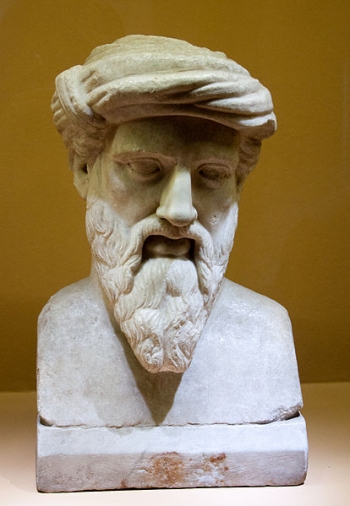What’s in a Name? (Or, what has Pythagoras got to do with this anyway?)
It is generally thought that the School of Pythagoras acquired its name during the seventeenth century. At the time of its purchase by Walter de Merton in 1270, the building is recorded in the deeds as “the stone house in which Eustace, father of Richard Dunning, formerly dwelt”, but by the mid-fourteenth century, allusions to the ‘Stone House’ in official documents had been largely replaced with references to ‘Merton Hall’, a name still associated today with the early sixteenth-century timber-frame structure which forms a north-wing annexe to the School.[1] Over time, the distinctive title of the ‘School of Pythagoras’ has come to refer specifically to the two-storey Saxo-Norman masonry building, which now lines the far side of Merton Court.
While the precise origin of the name ‘School of Pythagoras’ is unknown, theories have been put forward in the effort to explain the building’s pedagogic and Pythagorean connections. The reference of the poet and antiquary, John Leland (1503-1552), to the ‘Schola de Merton’ in his Collectanea, for example, has prompted some to argue that Leland’s work marks a step in the transition from Merton Hall to the School of Pythagoras, though it is unclear whether ‘Schola de Merton’ was a term that was created by Leland himself, or whether the name was already in common usage by the time Leland used it. [2] The English antiquary, Francis Grose (c.1731-1791), in his “Account of Pythagoras’ School in Cambridge”, commented that the scholastic connection probably did exist prior to Leland, if it were indeed “the place as has been related, where Erasmus read lectures on the Greek language in the university”.[3] It is more likely that the connection between the building and a school was made gradually over time.
Putting aside the question of the School's transition from a domestic to a pedagogic space, the association with Pythagoras has proved equally perplexing. Critics over the past 300 years have tended to adhere to one of three theories: 1) that Pythagoras himself lived and taught there; 2) that the building accommodated scholars of a Pythagorean persuasion; or 3) that the building itself has certain physical features which appear coincidentally Pythagorean. Edmund Carter, in The History of the University of Cambridge (1753), for instance, suggests that the School of Pythagoras was where Pythagoras was reputed to have “lived and read lectures to the Youth of the University”, while the printmakers, Samuel and Nathaniel Buck, writing slightly earlier in 1730, link the name to philosophical tradition, rather than to the philosopher himself:
Whence it had its name is uncertain, whether a society of Gentlemen might not meet here, or live in a Pythagorean manner, not unlike a College life: or whether the Mathematicks, Morals, or other Philosophy might not have been held, or taught here in opposition to the General Philosophy of those times, is rather to be taken as possible Conjecture, than to be admitted as certain. [4]
That the shape of the building itself should resemble the Greek letter, upsilon (‘Y’) - a symbol traditionally used by Pythagoras to represent the two paths leading to Vice and Virtue - has also served as a hypothesis for the building’s distinctive name, while the internal layout of the School building has likewise encouraged an unlikely relation with the ancient philosopher, where “its very undercroft might not impossibly have had its share in somewhat imaging, if not his school at Samos, at least that more cryptick cave in his house at Croton, he shut himself up in”.[5]